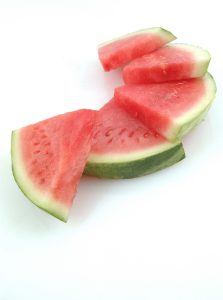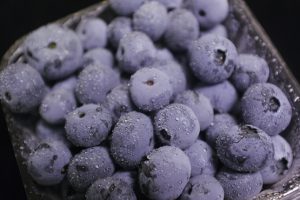
by Samantha Kennedy | Aug 19, 2020
A friend of mine recently shared with me a few recipes for what is known as “cooler corn.” As the name implies, it’s a way of cooking a large amount of corn on the cob all at once inside a cooler, thereby saving time and grill and/or stove space.
At first I was intrigued. I had never heard of this cooking method before and my own personal curiosity was piqued. However, as a certified food safety instructor, I was also immediately horrified. As I reviewed several recipes for this “perfect way to make corn for a crowd,” I became increasingly alarmed. There were so many proper food safety practices violated, it nearly turned my stomach.
Cooking food in a cooler is an unsafe cooking method. Coolers are not designed to withstand the high temperatures required for cooking and cannot adequately hold foods at safe temperatures for prolonged periods of time.
For the record: Cooking corn in a cooler is UNSAFE. The safest ways to cook corn are in a stockpot on the stove, in the oven, or on a grill.
Here are the top four reasons this cooking method is not a good food safety practice:

Cooking food in a cooler is an unsafe cooking method. Coolers are not designed to withstand the high temperatures required for cooking and cannot adequately hold foods at safe temperatures for prolonged periods of time. (Photo source: Samantha Kennedy, UF/IFAS Extension)
1. Coolers are not designed to be used for cooking. The plastic used in coolers is not meant to withstand continued exposure to boiling water and will start to degrade over time. The plastic can also be easily scratched or gouged, providing the perfect place for foodborne pathogens such as Salmonella and E.coli to hide and grow. Think of the other things coolers are used for: storing fish or game after fishing or hunting, keeping drinks cold, storing raw meat or poultry for a picnic, etc. There are so many other opportunities to contaminate the cooler before it is used for cooking corn, even thorough cleaning and sanitation may not be enough to eliminate pathogens. Always keep cooking utensils and tools CLEAN to reduce your risk of foodborne illness.
But what about the boiling water? Won’t that kill any pathogens? Well, yes and no. See #4 below.
And NO, having a cooler dedicated only to cooking corn will not solve all the problems stated above. The bottom line is COOLERS ARE NOT SAFE TO COOK FOOD IN.
2. One of the conveniences of this method, as celebrated in the various recipes, is that people can just reach into the cooler and grab a perfectly cooked ear or two whenever the mood strikes. Allowing people to reach in and grab food like this – especially with their bare hands – is a very unsafe practice. People may forget to wash their hands properly before reaching in, thereby adding dirt and bacteria to the water and thus the food. This type of “germ-sharing” is called cross-contamination and is one of the leading causes of foodborne illness. Always keep things SEPARATE. This includes keeping raw food separate from cooked food, using separate utensils for each food, and reducing or eliminating bare hand contact with food.
3. Stacking dozens of ears of corn in a container and submerging them in boiling water does not ensure that all of the corn will be cooked evenly. The ones in the middle may not be cooked all the way through and there may also be temperature fluctuations in different areas of the cooler because of the way the food is stacked. There may be hot, warm, and cool spots, which can lower the overall temperature to an unsafe level and promote the growth of pathogens. Always COOK foods to the proper minimum internal temperature. In the case of corn, this is 135 degrees F. This can be measured by inserting a properly calibrated food thermometer between two cooked ears of corn and waiting until the needle stops moving.
4. One blog post about the wonders of Cooler Corn stated, “You can leave the corn in there for quite a while after it’s done cooking to keep the ears warm. Since the temperature naturally drops over time, the corn doesn’t get mushy.” When I read this, my mind screamed, “DANGER!” in flashing red letters.
Boiling water is a good sanitizer. However, a lot of what makes it effective for killing pathogens has to do with proper contact time with surfaces AT THE APPROPRIATE TEMPERATURE. Most coolers are not designed to keep boiling water that hot (212 degrees F) for any significant period of time. Even quality coolers will not hold the temperature long enough to ensure proper sanitation and elimination of pathogens.
One of the most important food safety principles is keeping cold foods cold and hot foods hot. To ensure the safety of food, it is important to keep cold foods below 41 degrees F and hot foods above 135 degrees F.
Now think about ears of corn submerged in water for a prolonged period of time, as the water slowly cools. After a while, that water will no longer be able to keep those ears of corn above 135 degrees F. They will basically be sitting in a soup of tepid water at the most favorable temperature for pathogens to grow. The longer the corn sits in that water, the higher the risk of foodborne illness. Always properly CHILL foods to keep them at a safe temperature, below 41 degrees F. The flip side of this coin is to also ensure hot food stays hot, above 135 degrees F.
Cooking for large groups can be a challenge, especially when kitchen space is limited. (Check out the UF/IFAS Extension fact sheet “Food Safety at Tailgating” for more food safety tips when cooking out.) However, it is never a good idea to sacrifice food safety for convenience. Always follow proper food safety practices, no matter the situation, and remember the 4 principles of safe food: CLEAN. SEPARATE. COOK. CHILL.
UF/IFAS in an Equal Opportunity Institution.

by Ginny Hinton | Aug 17, 2020

Honey or Sugar
Photo Source: Ginny Hinton
Sugar or honey? The debate rages on, with honey probably edging out sugar in popularity. Many people use local honey because of it’s supposed benefit to allergy sufferers (immunotherapy). Others prefer it because it’s processed less than sugar, or because they simply love the taste.
People have been eating honey – or slathering it on their bodies – for hundreds of years. In ancient times, honey was used as a sweetener, as medicine to heal wounds, to relieve stomach problems, and even to fight bad breath. It has many of the same uses today. Honey contains trace amounts of acids that contribute to its antimicrobial activity, so when used on the skin it really can help heal wounds and reduce scar formation. The antioxidants in honey have been linked to properties that may fight cancer. Honey inhibits inflammation, leading to a protective effect for the heart and the whole cardiovascular system, and it’s a great remedy to help ease a bad cough. Does local honey really relieve allergies? There is some anecdotal (personal) evidence, but the jury is still out on that with no consistent clinical study results.
So, how do honey and sugar compare nutritionally? To start, both are carbohydrates, made up mainly of glucose and fructose. The body breaks them both down quickly and they each cause a spike in energy and blood sugar levels, although honey has a somewhat gentler effect. Honey weighs in with more calories at 68 per tablespoon versus sugar’s 49 calories per tablespoon. To balance out the calorie factor, honey is sweeter than sugar, so you may need to use less of it in your food. Honey may also be easier to digest because bees have already added enzymes that start to break it down. The bottom line is that both sugar and honey are sweeteners, they are nutritionally very similar, and using too much of either can lead to unwanted consequences such as weight gain, risk of illness, and tooth decay. Whether you use sugar or honey, it’s a great idea to limit consumption. The following tips may help, whichever sweetener you decide to use:
* Cut the amount of sweetener you use for drinks or
cooking in half and see if you still like the taste.
* Cut sweetener in baking by 1/3 or substitute mashed
banana for the sweetener.
* Add spices to substitute for some of the sweetener in a
recipe. Examples that add flavor without the calories are
almond, vanilla, and cinnamon.
Whatever tip you use, you’ll be ahead of the game if you can gradually cut the amount of sweetener you use, whether for cooking, baking, or drinking.
For more information about honey, sugar, or general nutrition, contact your local UF/IFAS Extension Agent.

by Terri Keith | Aug 4, 2020

Credit: Photo by JÉSHOOTS from Canva Free Images
Watermelon is a tasty treat so celebrating watermelons in August sounds like a great reason to break out all the delicious and healthy watermelon recipes I’ve been saving—like this one for Watermelon Limeade.
Did you know that eating watermelon provides your body with Vitamins A, B6, C and potassium? Red watermelons are also a good source of lycopene. A two-cup serving of watermelon only has 80 calories but can provide 6% of your daily value of potassium, 8% of Vitamin A, 25% of Vitamin C and more!
Watermelons are also completely edible, from the fleshy center part all the way out to the green rind. The rind is typically cooked or pickled before being eaten and Watermelon Rind Pickles are popular here in the Southeast. Ninety percent of watermelons sold in stores are seedless, but if you do get a seeded watermelon, the seeds can be cooked and eaten too! They are usually sprouted and roasted or dried first.

Photo Credit: UF/IFAS File Photo
Buying a whole watermelon versus one that’s pre-cut can be a better value, but you’ll want to make sure you select a ripe melon. There’s an old wives’ tale about thumping the watermelon but the best way to choose is by picking it up and looking at it. Here’s what you’re checking for:
- Look for a watermelon that doesn’t have any bruises, cuts, or dents. Some scratches are normal.
- Check for a buttery or creamy yellow spot. This is an indicator of where the watermelon rested on the ground while it ripened.
- The watermelon should be heavy considering the size. It is 92% water!
When you are preparing your watermelon, make sure to wash it before cutting into it. Use cool running water, scrub it with a produce brush, then dry it with a clean paper towel or cloth towel. Many people skip this step since it’s heavy and can be bulky but it’s an important part of maintaining your food’s safety. If you don’t wash your watermelon before cutting into it, you could be transferring bacteria from the outside of the melon to the inner flesh. Be sure your hands and any knives, utensils and cutting boards you will be using are clean as well.
An uncut watermelon can be stored outside of the refrigerator for a week if it wasn’t previously chilled. Once it has been cut open, it will need to be stored in an airtight container and refrigerated—you’ll want to enjoy it within a week.
When you think about eating watermelon, I bet the first image that comes to mind is eating a plain slice right from the fruit. And that’s great! Just keep in mind that watermelon can be made into drinks, added to salads, frozen into popsicles, incorporated in a stir-fry or slaw or even grilled!
Now, back to those recipes… here’s one for Watermelon Rind Pickles if you want to enjoy them right away (these will only keep for 2 weeks in the refrigerator) and this is one for canning Watermelon Rind Pickles so you have them year-round! And if you want more, try the recipe section at the Produce for Better Health Foundation or the National Watermelon Promotion Board. Celebrate watermelons this August by trying a new recipe or two with this amazing fruit!
Resources:
National Watermelon Promotion Board. Frequently Asked Questions: https://www.watermelon.org/watermelon-101/facts-faqs/
National Watermelon Promotion Board, Nutrition: https://www.watermelon.org/nutrition/nutrient-profile/
Produce for Better Health Foundation, Top 10 Ways to Enjoy Watermelon: https://fruitsandveggies.org/stories/top-10-ways-enjoy-watermelon/

by Dorothy C. Lee | Aug 4, 2020
The taste and fragrance of a cool, juicy slice of fresh melon in the summer just can’t be beat. Melons have been a favorite fruit for many centuries. They appear in Egyptian tomb paintings dated to 2400 B.C., and they are mentioned in the writings of the early Greeks and Romans. Mark Twain called watermelon “the food that angels eat.”
Uses & Preparation
Watermelon, honeydew, and cantaloupe are excellent cut up in salads, as a dessert, or alone as a cool, refreshing snack anytime. To save space and cooling time in the refrigerator, cut up the melon and cover tightly with plastic wrap.

UF/IFAS Photo
Selection
Thumping watermelon to judge ripeness is not always accurate, because you can’t tell if it is ripe or overripe. Instead, look for a well-proportioned melon with full ends, a dull outer skin, and the bottom a yellowish color, or turning from white to pale green.
Cantaloupe should have no sign of a stem, be nicely rounded, and the netting should be evenly distributed. Golden-colored melons with a mild melon odor are the peak of ripeness, while green ones will ripen in a few days if kept at room temperature.
A ripe honeydew melon has a creamy yellow rind that is soft and velvety. The best – tasting honeydew smells slightly fruity. Hold a honeydew at room temperature for a few days for even tastier fruit.
Melon Salad
Arrange balls or slices of watermelon, cantaloupe, or honeydew melon, alone or in combination, on lettuce. Serve with French dressing. Diced apples, diced pears, nuts, and chopped celery may be added for variety.
Chicken & Watermelon Salad
5 chicken breast, boned, skinned, cooked and cubed
3 cups watermelon, cubed
3 cups pears, cored and cubed
1/2 pound sliced mushrooms
1/2 pint low-calorie Italian dressing
Combine all ingredients, toss gently. Refrigerate on hour, stirring occasionally. Serve on a bed of lettuce.
Nutrition Information
Low in sodium. Low in calories. Good source of vitamin A.
Available Fresh
June – August
To learn about fresh Florida melons, please read our fact sheet: Panhandle Produce Pointers – Melons
For more delicious produce preparation tips, please visit: http://www.panhandleproducepointers.com.

by Laurie Osgood | Jun 15, 2020

Photo Source: Laurie Osgood
With everything going on in the world today, it could be easy to forget one of the most important holidays of the year, Father’s Day. We will celebrate Father’s Day on June 21st this year, during Men’s Health Month! Father’s Day is a good time to show the men in our lives that we want them to be with us for a long time. Let’s celebrate Men’s Health Month by encouraging the men in our lives to adopt healthy habits and seek regular medical advice.
Most men do not like to go the doctor. A 2014 survey conducted by The Centers for Disease Control (CDC) determined that American men are much less likely to go to the doctor than women. Starting a conversation could encourage him to pay attention to his health as he ages. But how do we start the conversation with our father’s about their health issues? To ensure a stress-free conversation, pick a time and place with few distractions and present the topic in a loving and non-judgmental manner.
Here Are the Top Healthy Living Tips for Men:
- Schedule an annual physical exam: Annual physical exams can help spot potential problems before they get serious. Only you and your doctor can determine your best checkup and screening schedule. Preventative screenings such as an annual colonoscopy are based on a patient’s age and risk factors for developing a condition or disease, including family or personal history, age, ethnicity, and environmental exposure.
- Recognize the Signs and Symptoms of a Heart Attack: According to the American Heart Association, someone in the U.S. has a heart attack every 40 seconds. Therefore it is important for everyone to recognize the signs of a heart attack. These warning signs include pain or discomfort in the jaw, chest, arms, shoulders, neck, or back, feeling light-headed or weak and shortness of breath.
- Make sleep a priority: Many adults don’t get enough sleep. Sleep is essential for our bodies to maintain our healthy bodily functions. Sleep disorders and ongoing lack of sleep can increase the risk of heart disease, high blood pressure, stroke, and diabetes.
- Reduce Stress: High levels of stress can negatively affect a man’s lifestyle. Stress can be life threatening and can lead to a heart attack. UF/IFAS Extension’s Electronic Data Information Source (EDIS) offers a collection of information on various subjects including how to manage stress.
- Stop Smoking: Men who smoke are at a greater risk for heart disease, cancer, respiratory diseases and strokes. Quitting can help lower the risk for smoking-related illnesses. The Florida Department of Health’s Tobacco Free Florida campaign offers resources to help quit tobacco use.
- Exercise More: Regular workouts can improve heart health as well as reduce stress and weight. Experts tell us that we should all try to get at least 30 minutes of moderate physical activity each day to maintain a healthy lifestyle.
- Eat Healthy: A healthy diet should include a variety of fruits and vegetables, whole grains, lean meats, and low-fat dairy products daily. USDA offers tips for Men’s Health; 10 Tips: Get the Facts to Feel and Look Better .
Father’s Day is a great time to celebrate the men in our lives and encourage them to pay attention to their health and well-being because we want them to be around for a long time.
Going to the doctor may not be as fun as going to a ballgame or the beach, but having a conversation about their health may be the gift we can give our fathers on Father’s Day.
For more information on healthy living or other extension related topics, contact your local UF/IFAS Extension Agent.
Extension classes are open to everyone regardless of race, creed, color, religion, age, disability, sex, sexual orientation, marital status, national origin, political opinions or affiliations.

by Dorothy C. Lee | May 11, 2020
Once known as star berries because of the pointy flower calyxes on top, blueberries have grown wild in North America for thousands of years. They were a staple among Native Americans, who dried and smoked the berries, and pounded them into venison to flavor the meat.

Berries such as blueberries are rich in vitamin, minerals, and antioxidants and can be delicious additions to yogurt, salads, and smoothies. (Photo source: UF/IFAS file photo)
Uses & Preparation
Wash blueberries just before using. Add to yogurt or cottage cheese or any fruit and mild cheese platter. For color and great taste, add to salads; or sweeten pancakes, cakes, and muffins.
Selection
Look for firm, dry, plump, smooth-skinned berries with a light grayish bloom. Ripe berries should be deep-purple blue to blue-black.
Storage
Cover and refrigerate fresh berries for up to 10 days. Blueberries are easily frozen for later use. Freeze unwashed blueberries in airtight, resealable plastic bags. If thawed, keep refrigerated and use within 3 days.
Blueberry Pancake Stacks
Vegetable Oil for cooking
1 cup milk
1 tablespoon vegetable oil
1 egg
1 cup all-purpose flour
1/2 teaspoons baking powder
1 teaspoon salt
1 cup fresh blueberries
Dash of nutmeg
In a mixing bowl, stir together the milk, oil, and egg. In a separate bowl, combine the flour, sugar, baking powder, salt and nutmeg. Add dry ingredients to the milk, and stir just until mixed (batter should be slightly lumpy). Gently fold in the berries. Spoon the batter onto a griddle or pan greased with vegetable oil and heated to medium-hot (dollops should be about the size of a silver dollar). Let the batter cook until the tops of the pancakes begin to bubble, then flip and cook until done. Stack and serve immediately with softened margarine and warm syrup. Makes about eighteen 2 1/2″ pancakes.
Blueberry Syrup
Combine 1 pint of blueberries and 1 cup of maple syrup in a saucepan. Heat to boiling, then lower the heat and simmer until most of the fruit has burst. Remove from heat and use a fork to mash the berries. The syrup will thicken as it cools. Store in the refrigerator for up to 2 days.
Nutrition Information: Good source of vitamin C. High in fiber. Low in calories.
Available Fresh: April – June
To learn about fresh Florida strawberries, please read our fact sheet: Panhandle Produce Pointers – Blueberries.
.For more delicious produce preparation tips, please visit: http://www.panhandleproducepointers.com.
UF/IFAS Extension is an Equal Opportunity Institution.













